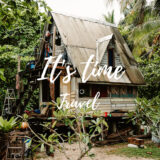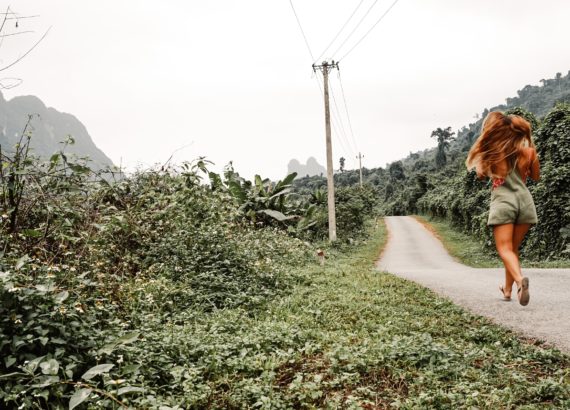My Camino de Santiago || 8 Days Itinerary


I can’t remember exactly the day I decided I wanted to do the Camino de Santiago, I remember that idea first hit me somewhere in Asia, for no strong reason and no specific goal, I just felt I wanted to do it.
“There are dreams we don’t even know we have” – I remember thinking, as my feet covered a path taken by so many before me.
So many different times. Different generations. Different motivations. So much history has passed by there and now here I am. Mixing my story in the Camino story, which in the end is a path without time.
In this article, I bring you a little bit of my experience, as well as my 8-day itinerary along the Portuguese Way of Santiago and some more tips.
A LITTLE OF HISTORY
AFTER ALL, WHO IS SANTIAGO?
Santiago or São João Maior was a fisherman who later became one of the twelve apostles of Christ. He returned to Jerusalem after Jesus’ death, becoming a great preacher of the Faith. However, his enthusiasm did not please Herod Agrippa, who condemned to death in the year 44 in Jerusalem.
COMPOSTELA OR THE STARS FIELD
It was the year 813 when one night, a hermit monk named Pelayo witnessed a shower of stars falling on a certain point, and interpreting this vision as a divine sign, he decided to investigate the place, finding an old tomb.
Pelayo then addressed Bishop Teodomiro, telling him what he had found in a “field of stars”, or “campus stellae“, in Latin, thus giving rise to the name Compostela.
The bishop, from the inscriptions on the tomb, confirmed that it was the tomb of Santiago, who was known to have been buried somewhere in that region. Later, he decided to report the case to King Alfonso II of Asturias who, in turn, decided to walk to the site to confirm the facts.
In this way, King Alfonso II is theoretically the first pilgrim from Oviedo to Santiago, walking what is now known as the Primitive Way or Camino Primitivo. Arriving at the site, Alfonso II officially confirms the veracity of the information and orders the construction of a small church in the place where the tomb was found.
Thus, slowly beginning to grow what we know today as the city of Santiago de Compostela.
THE DIFFERENT PATHS OF THE CAMINO DE SANTIAGO


There is no ONE Camino de Santiago, there are several, so many that I dare say there should be for all tastes!
This is because the Camino de Santiago starts from the front door 😅, in other words, once each pilgrim made his own way. In this sense, some routes become more popular than others.
However, the official route is known as the “French Way” or “Camino Francés” with 775 km to go (which is already on my list, obviously), as it is the most traveled since antiquity and was considered a world heritage by UNESCO in 1993.
Another of the most traveled routes is the “Portuguese Way of Santiago”, which starts in Lisbon, completing a total of 634 km. However, most pilgrims choose to start the journey in Porto (240 km), in Valença do Minho (120 km) or in the city of Tui.
Tui, is a Spanish border town and the last possible starting point to purchase a Compostela, since this is only granted if we cover at least 100 km on foot. To obtain Compostela it is necessary to stamp the Pilgrim’s Credential (there will be an article about this) at least twice a day.
MY CAMINO DE SANTIAGO
I must confess that when I started my research I felt lost with so many paths, I felt like a dizzy cockroach without knowing what to choose, where to start, how many days to walk, and so on!
So, I decided that as it would be the first time, I wanted to take the more traditional path and in this way, I chose the “Central Portuguese Path”. Another point I didn’t give up was starting in Portugal, but not just starting, I wanted to walk around my country for a few days.
As it would be my first time on pilgrimage, and my mother and aunt would be my companions, I decided to calm my impulses to eat the world and stipulate an amount of time that would not be too long or too short. 10 days seemed reasonable 😃.
I decided to start in Ponte de Lima for two very important factors:
- First, because Ponte de Lima – Rubiães stage is one of the most beautiful of the entire route (today I can confirm that to you) and I always like to start in big!
- Second, because the previous stage would be Barcelos – Ponte de Lima, which is a difficult stretch, consisting of more than 35 km and several unlevels (it’s confirmed, no pilgrim told me happy about this stage) and I didn’t want to start killing right away.
And it was the best decision I could have made because “My Camino” got a 10 in 10.
Let’s do it?


PONTE DE LIMA TO SANTIAGO DE COMPOSTELA || 152 KM
DAY 1 || PONTE DE LIMA TO RUBIÃES 18KM
Ponte de Lima is a charming town that I discovered to be the oldest town in the country! I wasn’t surprised, because it really breathed history there, everywhere. It was good to be able to enjoy it without the fatigue of a walk, although I didn’t have that perception at the time 😅.
The route from Ponte de Lima to Rubiães was, without a doubt, one of my favorites. Firstly because we have the enthusiasm of the beginner, but also because we were followed by nature in its purest state most of the way.
However, this is the day you’ll have to climb the mythical Serra da Labruja. I say mythical, because people started talking to us about this mountain range since breakfast, and it was the most exchanged subject among the pilgrims we met that day.
When you think you’ve climbed the mountain range. Remember, the worst part is yet to come.
Personally, I expected something worse, however, I almost saw my mother having a “something bad” at the end of the climb! So don’t underestimate it. In just over 4km, you’ll have to overcome a 300-meter drop in gravel.
LIFE TIP- At the end of this climb, when the trees start to disappear on your left side, look out for a half-hidden arrow that indicates the direction to the left. Generally, the pilgrims go ahead in this part. However, if you go left, you’ll find an amazing place, with a cold water tank, lawn, shade, and everything you could ask God for after that climb. It was my paradise.
How did I find this out? I don’t think I’ve told you this part yet, but several angels appear in the form of people along the way, believe me.
The day ends in the tiny village of Rubiães, where I stayed in the most welcoming accommodation of all, with a group of pilgrims from all over the world, all united by the same experience.
DAY 2 || RUBIÃES TO TUI 20KM
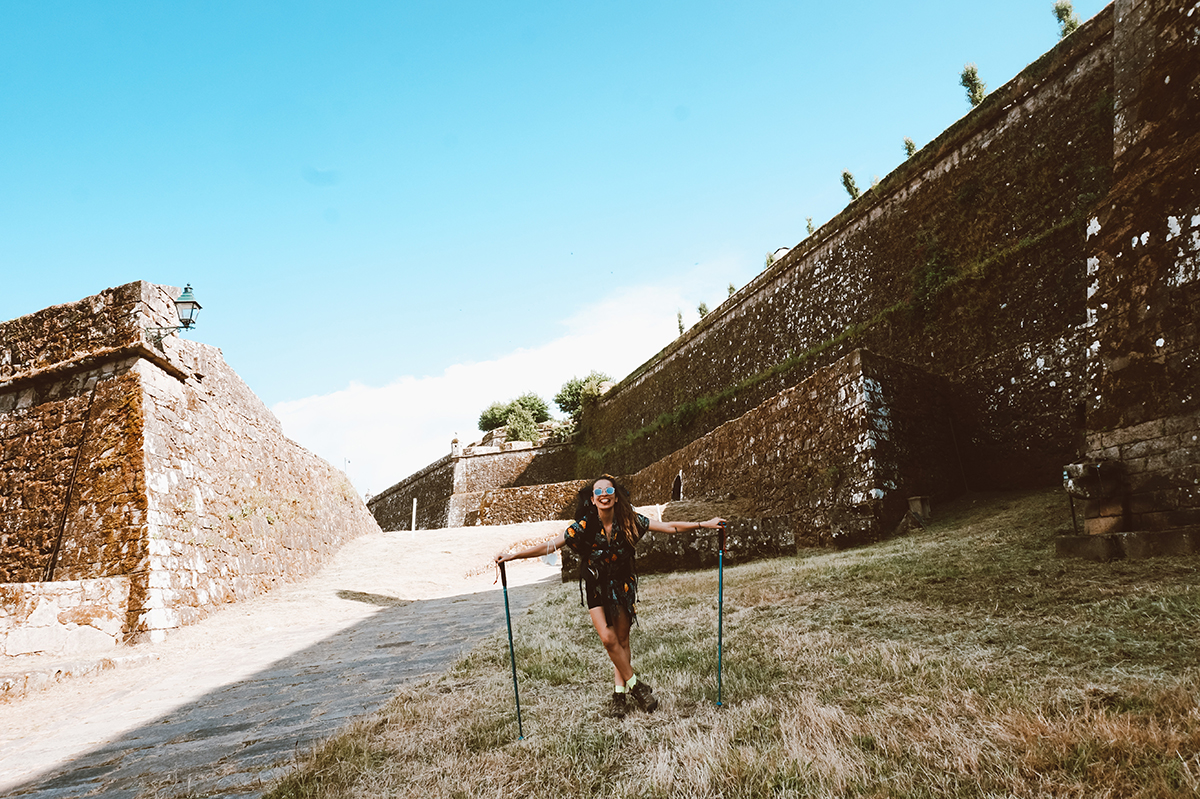

The day you say goodbye to Portuguese territory is peaceful and without any major unlevellings, on a route divided between nature and small villages.
My initial plan was to finish this day in Valença do Minho and only cross the border the next day. However, I couldn’t find accommodation compatible with my budget and decided to move on.
When I arrived in Valença do Minho I was a little sad because I felt like staying there, the vibe inside the castle was very good and I just wanted to take my backpack and enjoy the live music with a beer in my hand.
But we went to Tui and today I don’t regret it at all! Tui has all that vibe of crowded Spanish squares and its center is enchanting. Not to mention that the next day it feels good to meet the pilgrims who woke up an hour earlier and who have already traveled 5km, while you’re fresh to start the day!
LIFE TIP – Halfway through the route you will find a hostel called “Albergue Quinta Estrada Romana”. It is perfect to stop and drink an iced coffee to refresh. The owner is very friendly and will give you good tips and to top it all off they have the best stamp on the Camino de Santiago, painted by their 4-year-old daughter.
DAY 3 || TUI TO O PORRIÑO 16KM
Get ready to spend an amazing day! First, because it’s only 16km and that distance, as my aunt says, becomes “a drop in your ocean”, especially when you don’t even have gaps to overcome 😃.
The route will lead you through pedestrian areas and woods. Where you’ll probably make more stops than usual, once is hard to resist the fresh cold water you’ll find along the way.
LIFE TIP – In the past, it was necessary to cross an industrial area called As Gándaras to enter the town of Porriño. And it is said to be a very flat stretch of tarmac road. However, an alternative path was created about 3km longer, but which passes outside the industrial area, and takes you through a forest, flanked by the river Louro.
Yes, or yes, follow the alternative way! It was the most beautiful part of the day, where we stopped for over an hour on a lawn by the little river to take advantage of the sunny day. The beauty of the Camino de Santiago.
The Alternative Path is easily found, you will see two identical landmarks, one tells you just the kilometers and the other has C.Complementario written on it, and this is the one you have to follow. I guarantee you that every step is worth it.
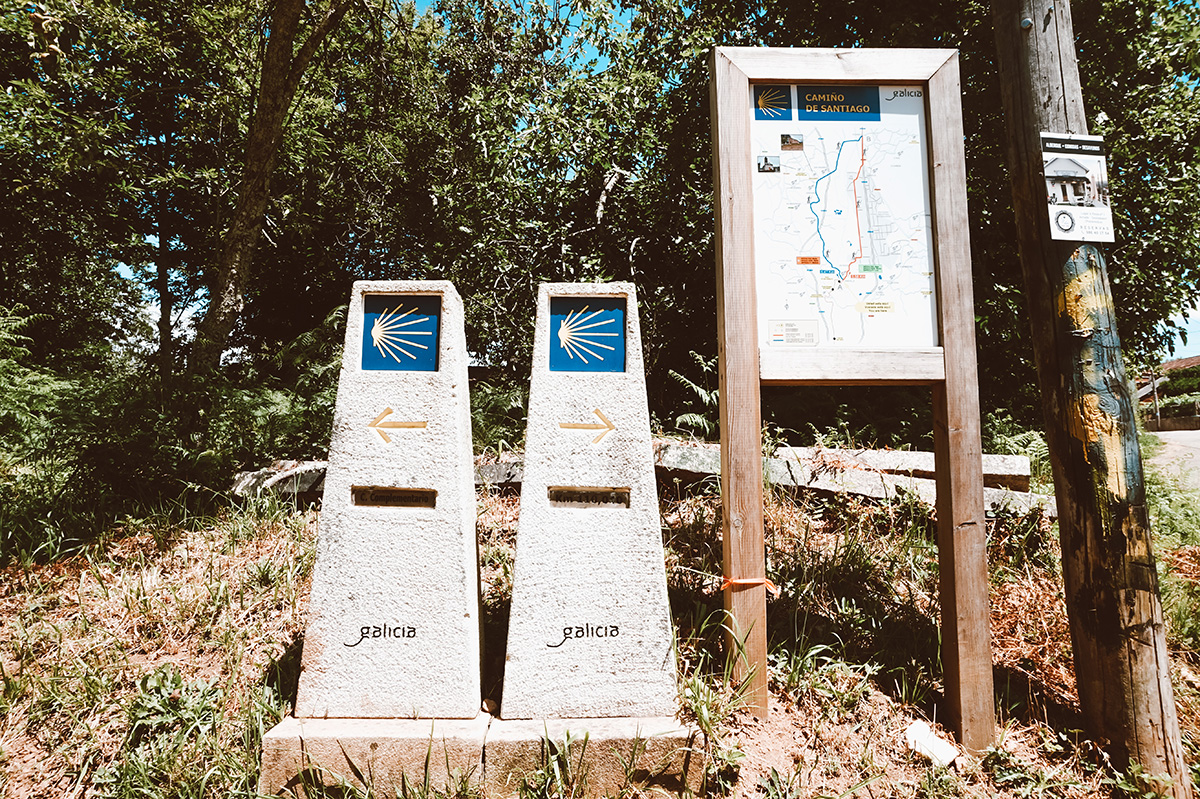



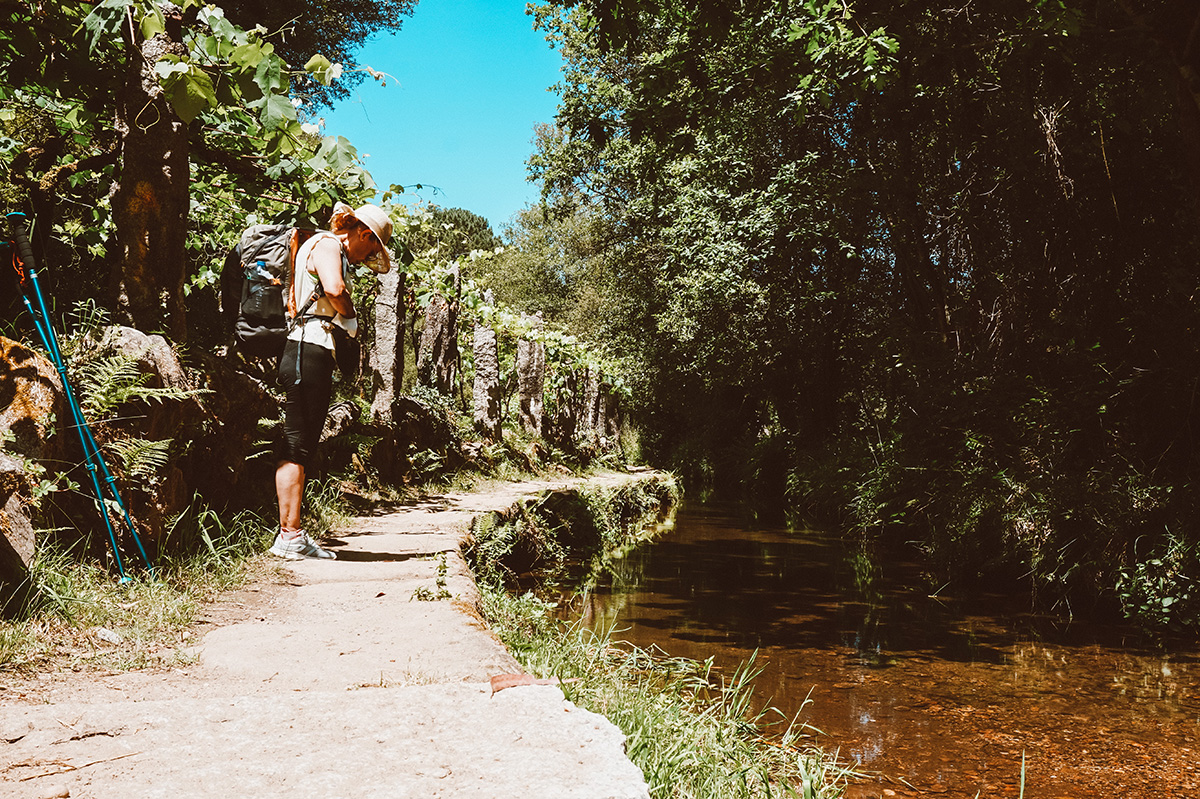

DAY 4 || O PORRIÑO TO REDONDELA 16KM
Despite being a few kilometers, it was the day that I considered less special. Used to happily walking through enchanted woods, I came across a day mostly done on a tarmac road.
There are some steep climbs, however, the biggest one is between the Albergue de Mos and the chapel of Santiaguiño that we didn’t do. I’m sorry I can’t write you the “life tip” for this but even today, I don’t know which direction we chose differently, or at what point we got mixed up with the arrows. However, when we realized, we had passed the people ahead of us and skipped the part of Mos ascent 😂, which I thought was brilliant!
DAY 5 || REDONDELA TO PONTEVEDRA 20KM
To make up for all the tar-covered the day before, today will be mostly done through woods and dirt roads, you will love it.
However, get ready for some pretty steep climbs that are sure to take your breath away. The first is right at the beginning of the stage, about 3km from Redondela, just to start your day 😅. And the second is after the Sampaio bridge, right in the middle of nature, made from a very uneven floor and with loose stones.
This was the hottest day ever, and I swear to you, on that stretch of road I felt like climbing a desert, the environment was so dry and hot (but I’m a bit exaggerated, so don’t take it literally 😊).
LIFE TIP – About 5km from Pontevedra you’ll find another alternative route, very well signposted, like the one you found on day 3. And what’s the tip? Once again, follow the complementary path, because every little step is worth it!
The entire route is flanked by a river of crystal clear water and you are taken to walk through a wood that looks like something out of a Disney story. Believe me, I had the hamstrings in my feet in panic, and even so, it was impossible not to be impressed on this path, I even had the right to hug a giant tree!
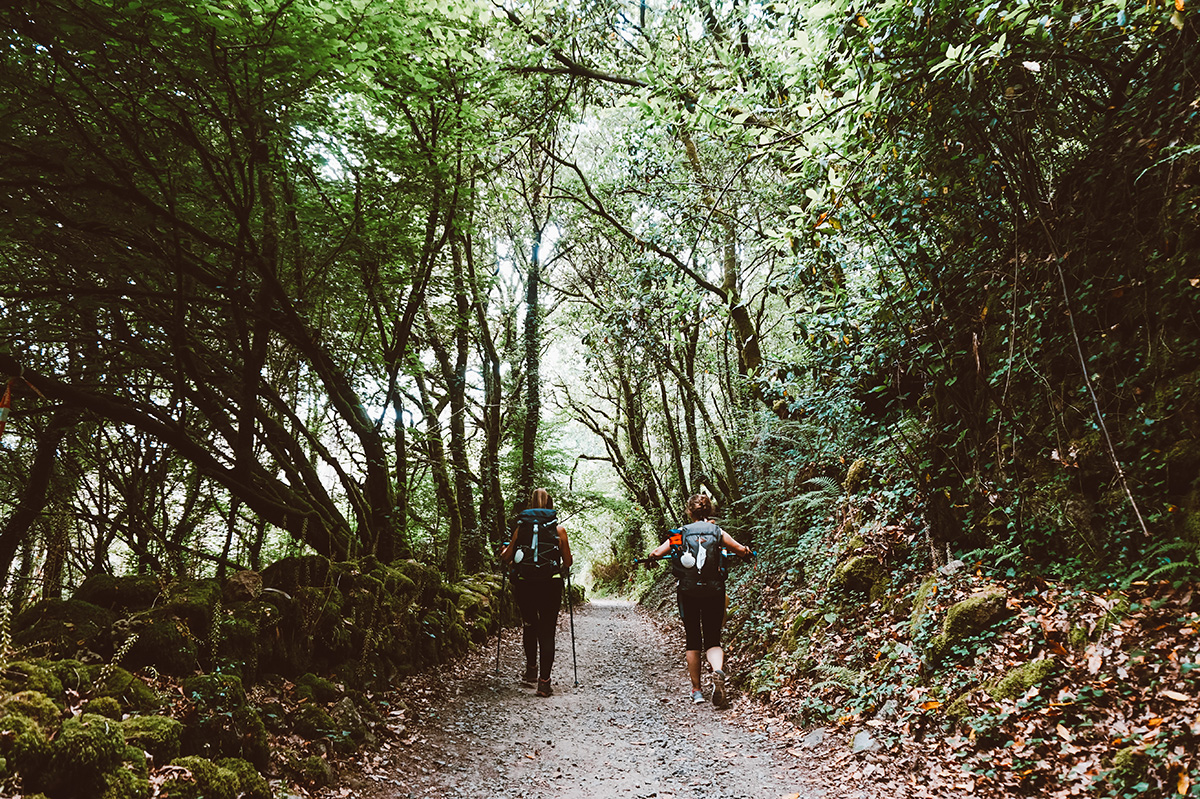

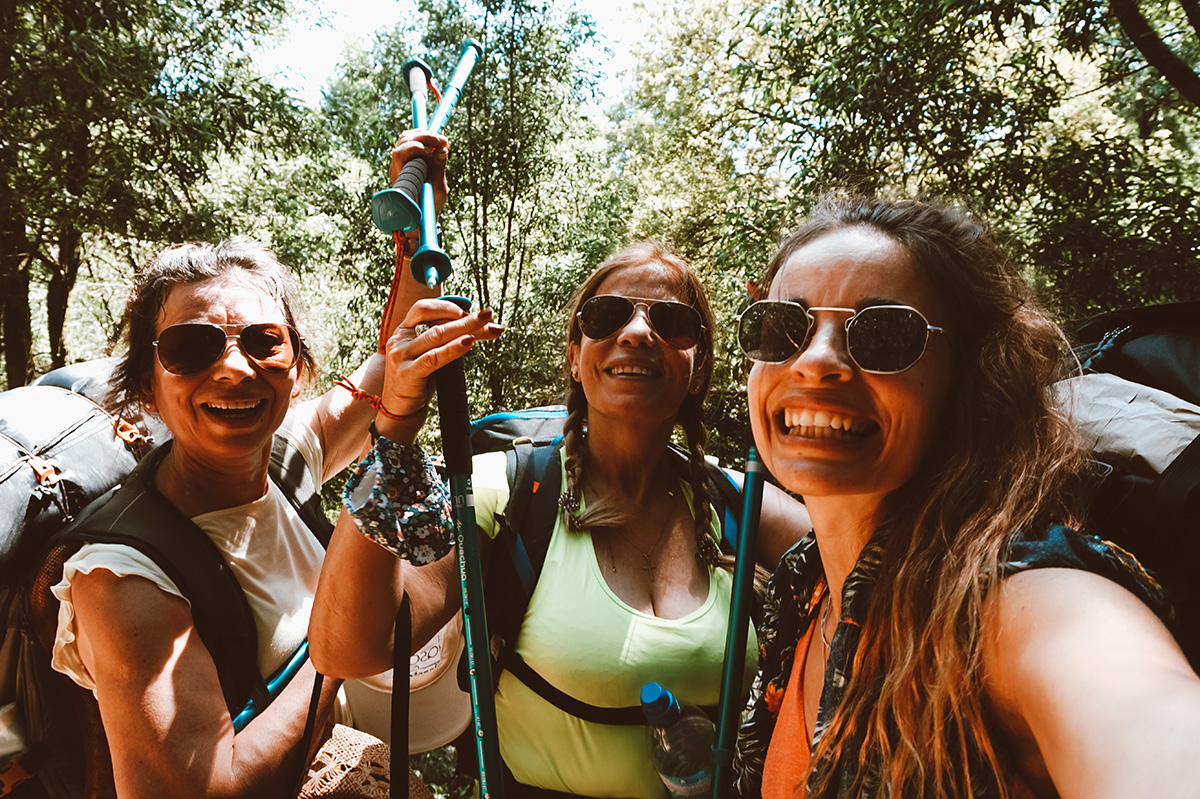

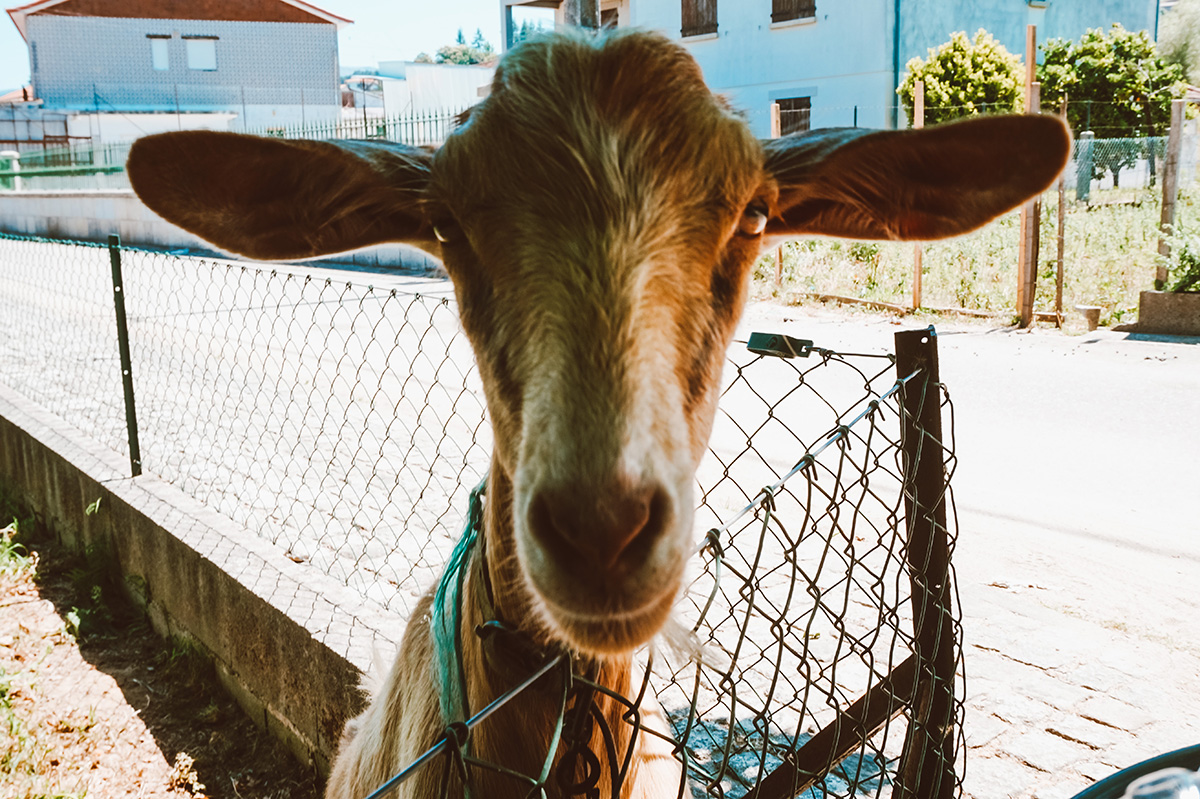

DAY 5 || PONTEVEDRA TO CALDAS DE REIS 22KM
You start the day by crossing the entire historic center of Pontevedra, which in my opinion, is one of the most beautiful cities we’ve passed.
Leaving the city behind, we enter a more rural landscape in Galicia, where we cross several villages, several wine fields and are presented with seasonal fruits by some trees on the way.
Contrary to the previous day, this stage has no big gaps and is quite easy to do. However, you’ll have to do several kilometers on the tarmac and a final part of the route is shared with the N-550, a very busy road.
It’s not a bad day, but it won’t fill you up either.
DAY 7 || CALDAS DE REIS TO PADRÓN 19KM
Just remembering this day, I even take a deep breath 😅.
It was a day that rained heavily all the way and it was very hard for me. It is not easy to walk in the rain, with the weight, fatigue, and pain accumulated. However, someone told me that the Camino without a rainy day is not the Camino. It was my litmus test.
But, experiences aside, this part of the journey is beautiful! And if it weren’t for the rain, I’m sure it would be one of the best days. Since there are no big gaps to be overcome and we pass through areas of abundant nature where it is difficult to remain indifferent.
Padrón is a city with a lot of history and equally important to the history of Santiago. It was through this city, according to legend, that the remains of Santiago entered the Iberian Peninsula and the stone (or padrão) to which the boat was attached is currently found under the altar of the Church of Santiago de Padrón.
DAY 8 || PADRÓN TO SANTIAGO DE COMPOSTELA 25KM
The last day!!!
This is considered one of the most difficult days because it is the stage where we have to overcome the biggest gaps since we entered Spanish lands. However, with the trauma, I had from the day before and as I had psychologically prepared myself to do it in the rain (which I didn’t), this day was extremely easy for me. When we are expecting the worst, any ray of sunshine makes us feel grateful!
But yes, there are some steep climbs here and there, however, it is the last day and there is that strange energy that you are arriving and you want to arrive but at the same time, you want the Camino to continue.
At a certain point, you will see the Cathedral towers from afar and it is likely that your heart will leap, after all, it is to get there that you have been walking for days without stopping. However, you’ll still have plenty to walk, it’s also likely that your pace will speed up a little, it’s the enthusiasm!
And when you realize, you’re already walking through the streets of Santiago de Compostela, towards the Cathedral that gains dimension with every step.
And you arrive. It’s a strange feeling to arrive.


ACCOMMODATION
WHERE TO SLEEP ON THE CAMINO
All over the Camino de Santiago, there are so-called public hostels, which would be the cheapest option, since their values are around €5-8. However, due to the pandemic, these hostels are mostly closed.
The second viable option is to stay in inns or hostels, which are evenly distributed along the way. It’s a more expensive option, but you’ll definitely get better nights’ sleep, essential for you to continue on your way.
In my research I noticed that several people did a mixture of both, some nights they stayed in public hostels and others in hostels. As for me, I didn’t have the opportunity to experience a public hostel.
HOW TO LOOK FOR ACCOMMODATION
I recommend the website Groze.com , it has plenty of information about all stages of the Camino de Santiago, including a list of public and private hostels you can find at each stopover.
Another tool that was VERY useful to me along the way was the Camino Ninja application, created by a pilgrim. I used it to find accommodation, to check the kilometers of each stage and their elevations, and as a map. Whenever I didn’t see the yellow arrows for a while, I would open the application and easily see if I had strayed off course or not. Therefore, I recommend it 100%!
MY ACCOMMODATION OPTIONS


PONTE DE LIMA
Pousada da Juventude de Ponte de Lima – 15€ / night, breakfast included. Grade 5/5.
More accommodation options: Ponte de Lima
RUBIÃES
Alojamento Ninho Rubiães – 15€ / night, with breakfast, included. Grade 5/5.
Email: nest.albergue@gmail.com || Tel: +351916866372
More accommodation options: Rubiães
TUI
Jacob’s Hostel – 14€ / night, breakfast included. Grade 5/5.
More accommodation options: Tui
O PORRIÑO
Alojamiento Camino Portugues – 13€ / night, excluding breakfast. Grade 3/5.
More accommodation options: Porriño
REDONDELA
Albergue de Santiago de Villavella – €15 / night, excluding breakfast. Grade 4/5.
More accommodation options: Redondela
PONTEVEDRA
Albergue GBC Hostel – 16€ / night, excluding breakfast. Grade 5/5.
More accommodation options: Pontevedra
CALDAS DE REIS
Pensión Augas Quentes – €15 / night, excluding breakfast. Grade 5/5.
More accommodation options: Caldas de Reis
PADRÓN
Cruces de Iria – 14€ / night, without breakfast. Grade 5/5.
More accommodation options: Padrón
SANTIAGO DE COMPOSTELA
Meiga Backpackers Hostel – 15€ / night, excluding breakfast. Grade 4/5.
More accommodation options: Santiago de Compostela
*You can find all the accommodations mentioned on the Booking.com website, with the exception of Alojamento Ninho in Rubiães, which you need to get in contact with directly.
YOUR CAMINO DE SANTIAGO
Each one has their own experience, their way of living things, so I didn’t want to dwell in this article on what I felt, because you will feel your own Camino de Santiago, it will be your journey. A pilgrim told me on the very first night:
Nobody feels the Way in the same way. And every time you do it, even if your feet travel the same road, it will be a different Path.
So, in no way do I want to influence your feeling. I really want you to grab your backpack and put your foot on the road because this is one of those experiences that are really worth doing.
Let’s go?
*You can find the whole adventure on my Instagram, in Highlights called Camino 😉


